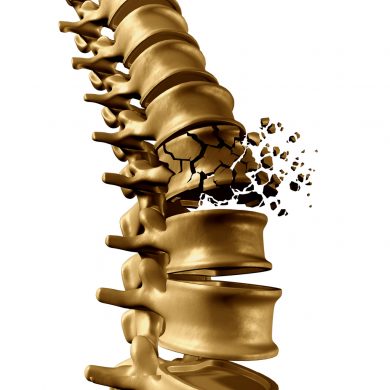Females over the age of 50 are at risk for developing spinal compression fractures. It is a very common complication of osteoporosis, a bone disease that affects post-menopausal women. In osteoporosis, bone mass decreases faster than it can be built up. Bones become weak and brittle and may break more easily than expected. A fall or even normal daily activities like bending and lifting can lead to compression fractures. Spinal compression fractures most commonly occur in the thoracic, or middle part of the spine. Compression fractures of the spine can lead to additional fractures, spinal deformity, and loss of function.

Symptoms
Osteoporosis often goes undetected until there is a compression fracture. Symptoms of a compression fracture include back pain, loss of height, and stooped posture. The pain from a compression fracture can be severe. However, some people don’t seek medical care because they assume their pain is just a part of the aging process. They don’t realize that there is a bone fracture that needs to be addressed. Other signs of a compression fracture include a humpback appearance, loss of balance, neurological symptoms such as numbness, tingling, and weakness, and increased pain when standing or walking.
Risk factors
Risk factors for osteoporosis directly relate to risks for compression fractures. Women are four times more likely than men to develop osteoporosis. Caucasian and Asian women have higher risk. Age, family history, and a small or petite body frame are other risk factors. Thyroid problems, Celiac disease, eating disorders, low calcium intake, and long-term steroid use also contribute to osteoporosis and bone fractures.
Diagnosis
Doctors can confirm a compression fracture diagnosis by conducting a thorough physical exam and medical history along with the ordering of x-rays. A CT myelogram scan is also useful for diagnosis.
Treatment
Non-surgical treatments include bed rest, pain medication, and a back brace to immobilize the fracture and stabilize the spine. When conservative treatments have not been effective, there are surgical options. Common procedures are vertebroplasty and kyphoplasty. These minimally invasive techniques rebuild the vertebral space with orthopedic cement and restore height. This strengthens the spine and helps prevent further damage. Most patients receive immediate pain relief following their procedure.
Prevention
Osteoporosis greatly increases the risk for additional fractures. Treatment of osteoporosis is key. Calcium supplements, increased vitamin D, weight-bearing exercises, and bisphosphonate medications are common treatments for osteoporosis.
The physicians at Atlanta Brain and Spine Care are experienced in diagnosing and treating spinal compression fractures. If you have osteoporosis and believe you may have suffered a compression fracture, contact us today to learn about your treatment options. We can develop a treatment plan that can help you return to a healthy, pain-free life.


